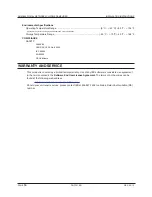
PAGE
4
DOC1212B
REV: 02-13
DNA78X4 DIGITAL NETWORK 4CH POWER AMPLIFIER
INSTALLATION INSTRUCTIONS
d. Check the procedures. Study the entire procedure before taking the first step. Consult the circuit dia-
gram frequently to obtain an understanding of what is accomplished at each step. Know what is in the
equipment and how it differs from others on which you have worked.
e. Be aware that high voltages may be present across terminals that are normally low voltage, due to
equipment breakdown. Be careful when measuring low voltages in equipment containing high voltage
circuits.
f. Do not make resistance measurements with power on.
g. Do not work within the equipment without the presence of a person who is capable of rendering aid,
and who is familiar with the procedure for emergency shutdown of the equipment.
PRECAUTIONS WHEN MEASURING HIGH VOLTAGE POTENTIALS
Observe the following precautions when measurements must be performed on circuits with potentials over
48 volts.
a. Do not measure potentials over 48 volts without the presence or assistance of a person who is capable
of rendering aid, and who is familiar with the procedure for emergency shutdown of the equipment.
b. Be sure you are not grounded when you are adjusting equipment or using measuring equipment.
Stand on a rubber mat or other insulator if possible. Be sure the equipment area is clean and dry. In
general, use only one hand when servicing live equipment.
c. If a test meter must be held or adjusted while voltage is applied, ground the case of the meter before
starting a measurement. Do not touch the live equipment or personnel working on live equipment while
holding the meter. The “common” terminal on some A/C electronic voltmeters is at ground potential;
never connect the “common” terminal to any point above ground potential.
d. High-voltage, high-capacitance capacitors should be discharged before servicing is started.
WARNING!
Discharging must be done carefully and judiciously. First ascertain whether there is a
built-in bleeder network. If so, wait a minute or two for the capacitor to discharge through the
network. Otherwise, use an external discharge network. This is most important in the case of high
voltage or high capacitance capacitors. If one terminal is connected to ground, connect the
discharge network between the other terminal and ground. If neither terminal of the capacitor is
grounded, connect the network across the capacitor terminals. Connecting a short circuit across
the terminals is not recommended. Doing so can produce extremely high currents and a flash
which can injure the eyes, vaporize metals, and cause burns.
PRECAUTIONS WHEN WORKING ON ENERGIZED EQUIPMENT
When it is necessary to work on energized equipment, think ahead and anticipate every hazard. Never work
alone on energized equipment.
Interlock switches are installed on some of the doors and panels to break the power circuits when the
enclosure is entered. When it is necessary to work within such an enclosure on energized equipment, the
interlock may be bypassed. Extreme caution should then be exercised, as dangerous voltages are present
within the unit.
AC POWER CIRCUITS
Equipment obtaining power from a secondary distribution system should be grounded at all times by
means of a third grounding wire on the power lines. Equipment permanently wired to a secondary distribu-
tion system should also be grounded separately by connection to a grounding bus or ground rod with a
sufficiently large conductor to handle the current expected if the secondary source is accidentally shorted
to the equipment.
The ground wire should be protected from mechanical damage and periodically inspected for good physi-
cal condition.






































